Ask most Americans why Detroit went bankrupt and virtually emptied out—plummeting from a population of 1.8 million to 700,000—and you’ll probably hear comments like the “globalization of the auto industry,” “race riots” and “corrupt, inept government officials” (often a code for black politicians). When the question is about Detroit today, the most common perception seems to be that it is rebounding rapidly, thanks to an influx of external saviors and moguls.
But every city, every community, has more than one story. And those who have chosen community development as their mission must seek them out—particularly from those at the bottom of the power chain.
From the mayor
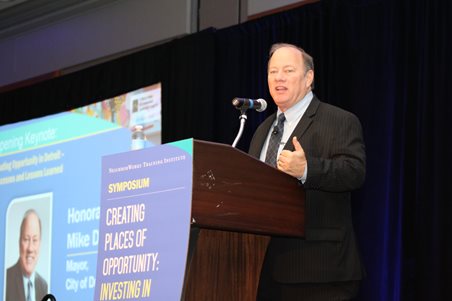 |
| Mayor Mike Duggan at the NeighborWorks symposium |
“The population of this city has declined every year I’ve been alive, until this one,” commented Duggan in his keynote speech at the Wednesday symposium, “Creating Places of Opportunity.” “More people wanted to leave than move in.”
However, he contested the prevailing narrative about what triggered that decline. “It wasn’t violent protests or corrupt mayors. In fact, Wayne State University predicted our decline as early as 1963 [four years before the urban revolt for which the city became known].”
Duggan cited an earlier trend as a key contributor to the large-scale population flight. Initially, the auto factories built up instead of out, and thousands of houses were built for the workers, right up to the plant borders.
“We built homes instead of high rises. People walked to work, which was great, but there was no land left for shopping malls or to accommodate a new type of factory, when it was discovered that one-story operations—with all phases of manufacture on one floor—are more efficient. So the malls and the factories left the city and moved out to farmland. The old plants started closing, and then no one wanted to live next to an abandoned plant. That started the emptying of entire neighborhoods. We now had abandoned plants and abandoned houses—acres of them.”
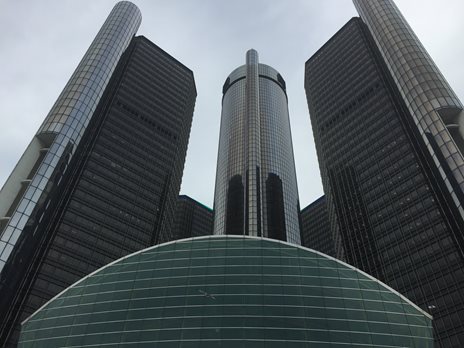 |
| Downtown Detroit's GM Renaissance Center |
Duggan’s story of the Detroit of today is one of resurgence. Yes, most of the impressive, modern hub that is now the downtown did not and still cannot happen without state, federal or private subsidies. But no one can argue that the recovery since July 18, 2013—when Detroit became the largest municipality to declare bankruptcy—has been remarkable.
How do you reverse such a dramatic population decline? Duggan has implemented three different strategies:
- Focus on small actions that make a neighborhood livable. For example, when Duggan came into office, “half the street lights were out. But last week, I installed the 58,000th light. I’m also maintaining public parks, and we’ve cut in half police response times.”
- Go for density. Instead of doing a little bit everywhere, Duggan and his administration have chosen specific, target neighborhoods for comprehensive interventions. The city government has aggressively gone after absentee owners who allowed their properties to decline, filing 50 lawsuits a week to force them to fix and occupy them within six months to avoid government take-over. The city now owns 35,000 houses and 93,000 parcels of land, demolishing buildings that can be saved and rehabbing and auctioning the others. Duggan estimated that about 70 percent of the houses the city has acquired now are occupied. More than 10,000 buildings have been demolished in just the last two and a half years. All demolitions completed and upcoming are publicly recorded and anyone can sign up to receive “Detroit dashboard” updates in their email inboxes. “I drive the neighborhoods every day,” Duggan said. “It is so fun to see them transformed.”
- Cultivate commercial strips with small businesses. An initiative called “Motor City Match” connects new and expanding businesses with real estate opportunities and provides the funding and technical support needed to promote success. Each quarter, up to $500,000 in grant dollars are available.
From grassroots community activists
Lisa Leverette, program director for the Community Connections Grant Program, attended the 11th annual member meeting of NeighborWorks America’s community building and engagement program. A third-generation Detroiter and the daughter of a public school principal, she went on to become a registered social worker and certified addictions counselor and youth worker. Community Connections is the grassroots grantmaking arm of the Skillman Foundation’s Good Neighborhood program.She has a slightly different perspective on the history and status of Detroit.
“Before the recovery began, the popular perception was that Detroit is a really awful, dangerous place—where brain drain has left no one with intellectual rigor to figure out a solution and poor, black people have pretty much destroyed the city,” said Leverette, who also manages the Lower Eastside Community Grant Program, which supports local groups and leaders. “The common joke was, ‘last one out don’t forget to turn lights off.’ But it was a majority-white city until the ‘70s and the decline of the manufacturing industry and other problems started way before then.”
While Leverette acknowledges that Detroit did, as Duggan noted, have one of the largest housing stocks in the world, she points to the election of the first black mayor, Coleman Young, in 1974 and the racism-driven white flight that followed as the biggest culprit. She also points to the auto industry-motivated ruin of the once-robust mass transit system and the construction of highways right through black communities.
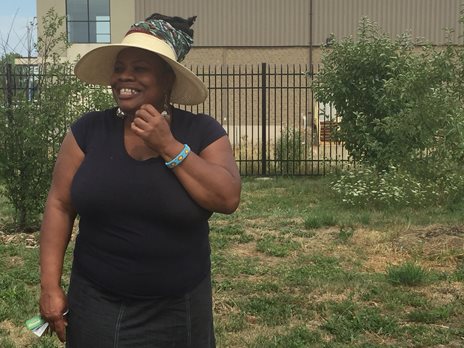 |
| Oya Amakisi |
However, she said, despite the discrimination and increasingly tough living environment, many Detroiters from all income ranges stayed and continued the hard work to revive the city—long before and during the influx of “saviors” prompted by dirt-cheap real estate and media coverage that depicted the city as an empty “new frontier.” For example, Oya Amakisi, community engagement manager for The Greening of Detroit, points to her organization, which has been working at the grassroots level since 1989. Today, it focuses on repurposing the land to create beautiful and productive green spaces, while also educating students on green, healthy living and generating jobs.
Leverette and others cites media coverage like this quote from the April 24 issue of Forbes: “The efforts of billionaire Quicken Loans founder Dan Gilbert and fellow billionaire Little Caesar’s Pizza founder and Detroit Tigers and Red Wings owner Mike Illitch have led to the types of revitalization that typified many cities in the ’80s and ’90s — downtown stadiums, office and entertainment development. Detroit’s Midtown, Corktown, Woodbridge, east riverfront and other areas adjacent to downtown have become hotspots, and now the city and its residents are contemplating the spillover effects of such growth into areas that have long been forgotten.”
Such quotes in the national media, residents say, have shaped an image that promotes projects widely considered wasteful and elitist (the stadium), disenfranchises the grassroots work of individuals and smaller nonprofits, and prioritizes the downtown over working class neighborhoods.
“The state and the city are supporting a stadium when we just cut pensions for municipal employees who’ve worked for Detroit 25-30 years, children are hungry and don’t have school books, we’re underpaying teachers and some residents lack clean water in this sweltering heat,” commented Amakisi.
Consulea Francesca Barber-Lopez, who works in community engagement and economic development for the Congress of Communities in southwest Detroit, added: “The financial moguls are buying everything up in some areas. In 2009-2010, they ran ads saying, if you move here, we’ll give you a cash incentive. Just come on in and take over some property. Like there’s no one here at all. Meanwhile, we’re being pushed out. I’m the last of the original residents able to stay in my row house.”
The result, the three women agreed, are “two Detroits”—the glittering downtown and Midtown and almost everywhere else.
“It's a clear red flag when you can sit in a hot new downtown restaurant and nine out of 10 tables are filled with white diners, a proportion almost exactly opposite of the city's racial make-up,” writes Nolan Finley in The Detroit News. “It should stop us in our tracks — as it did me the other day — when a group of 50 young professionals being groomed for future leadership shows up to hear advice from a senior executive, and there's only one black member among them. It's like playing with dynamite to have black Detroiters looking out of devastated neighborhoods at a downtown bustling with hope and hopeful young people, and not seeing their own children among that hip crowd.”
The philanthropists and businesspeople
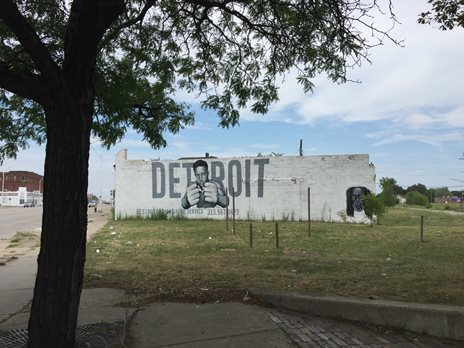 |
| Depicted in the mural is boxer Joe Louis, who grew up in Detroit. |
Tim Thorland, executive director of NeighborWorks member Southwest Housing Solutions, agreed, noting that two-thirds of the families in the area served by his nonprofit are at or below 80 percent of median household income—which means they can’t benefit from the surging home prices touted by Duggan. If anything, they’d be pushed out.
Sandy Baruah, president of the Detroit Regional Chamber, conceded that success in only targeted neighborhoods is insufficient.
“We can’t afford to have entire communities of people who are not participating in and benefitting from the recovery,” he said. “We need to be very intentional about this, and it’s where the business community oftentimes fall short. The margins for all industries today are razor thin. They’re competing with every person on the globe with an internet connection. It puts a lot of minority businesses at a disadvantage. We must find new ways to engage small companies of all kinds to help them get those opportunities.”
Still, from a practicality point of view, he argued that Duggan’s approach of starting where a difference can be made the quickest makes sense. “The neighborhoods are just too far apart to cover them all. And the reality is that there must be a sustainable benefit.”
Coming together on solutions
So what are some solutions? Conrad Mallett, chief administrative officer of the Detroit Medical Center, which was taken for-profit under the previous leadership of Duggan, said that investors and businesspeople “need a business plan that shows how diversity can work for them. It must be high in the priorities or you won’t get to it. For instance, we need to show that we all need affordable housing and education around us so that we have a diverse workforce to support our business.”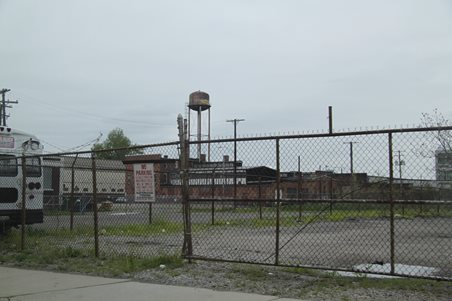 Allen agreed. “Show me your budget and your metrics and I’ll know your priorities. Growth and equity do not have to be separate. But it’s difficult to convince people of that. Likewise, we must recognize there are market failures, and thus there must be market corrections. I mean, look at Detroit. The sad truth is that this country does not have a wealth of good examples of economic inclusion.”
Allen agreed. “Show me your budget and your metrics and I’ll know your priorities. Growth and equity do not have to be separate. But it’s difficult to convince people of that. Likewise, we must recognize there are market failures, and thus there must be market corrections. I mean, look at Detroit. The sad truth is that this country does not have a wealth of good examples of economic inclusion.”She added that one simple measure that could be adopted would be to require global businesses located in the city to invest locally—just as Grand Rapids, Michigan, does. “We must clearly communicate that this place matters. If you do business here you must invest here.”
Amakisi agreed, saying requirements should be made of newcomers. “Come and be a part of Deroit, yes, but don’t come to ostracize and re-segregate.”
For her part, Leverette is hopeful. “The future Detroit will definitely be a different Detroit. It won’t be the city of my childhood. But a lot of people here are pushing back against the ‘blank slate’ narrative pedaled in the media and by the moguls. There are groups like the Detroit People’s Platform, We the People of Detroit and the Detroit Equity Action Lab at Wayne State University. It would be wise for folks to pay attention to these grassroots groups. There are a lot of encouraging conversations but conversations are not action. It’s time to codify what’s needed into policy.”
As for everyone in cities outside of Detroit, Leverette has this to say: “Whatever you do, get on the ground and get many perspectives. Go in and listen. There are so many different stories. Are you listening to only one?”

